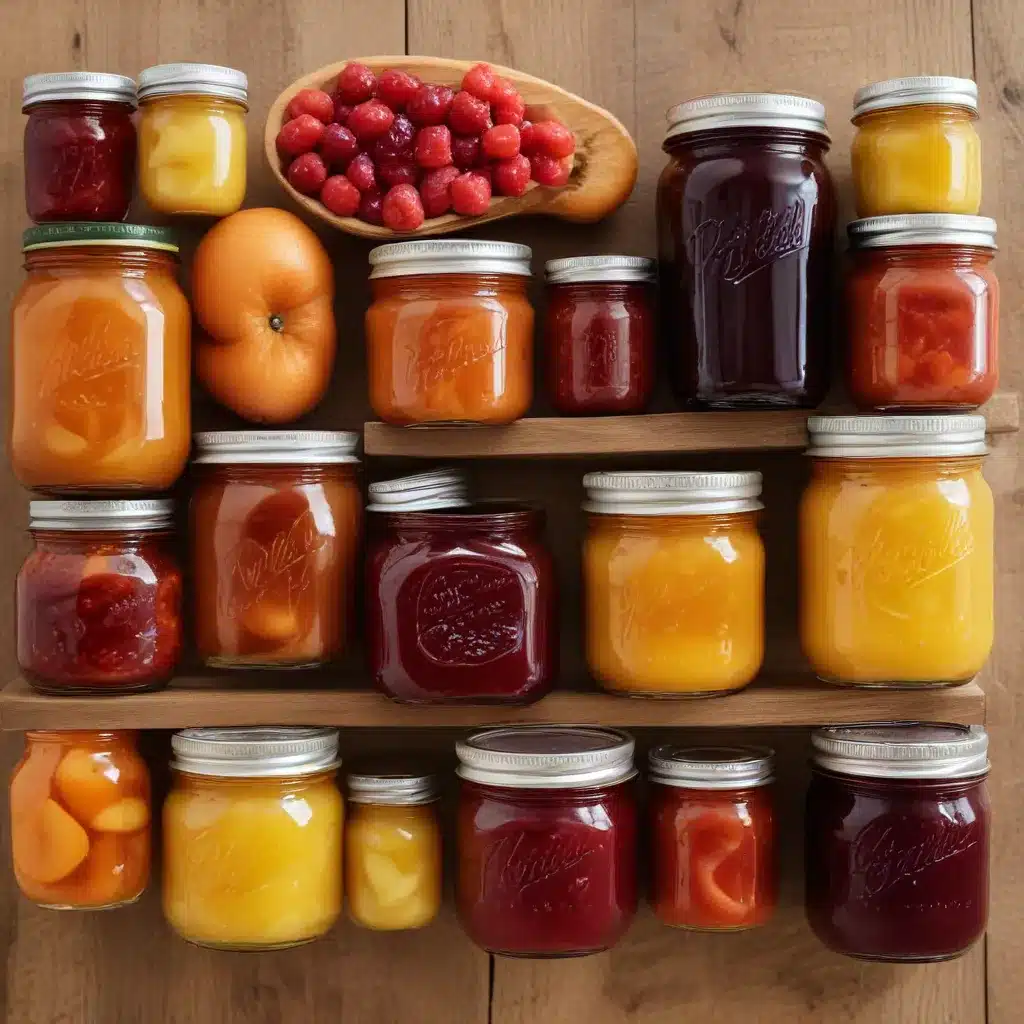
Nothing captures the flavors of the farm quite like homemade preserves. Whether it’s a tangy marmalade, a sweet strawberry jam, or a silky fruit butter, these shelf-stable treats allow you to enjoy the bounty of each season long after the harvest has passed. At Crooked Pines Farm, we take pride in our time-honored preserve-making traditions, crafting small batches of preserves that showcase the natural sweetness and vibrant colors of our freshly picked produce.
Jams and Marmalades
Jam and marmalade making is an art form that has been passed down through generations of farmers and homesteaders. The key is selecting the ripest, most flavorful fruit and combining it with just the right amount of sugar to create a preserve that is both sweet and tart.
Fruit Selection
When it comes to jams and marmalades, fruit quality is paramount. We source our berries, stone fruits, and citrus from trusted local growers who prioritize sustainable, organic practices. Strawberries, raspberries, blackberries, and blueberries make excellent jam bases, while oranges, grapefruits, and lemons lend themselves beautifully to marmalades.
Preparation Techniques
Proper preparation is the foundation of a great preserve. We carefully wash and trim our fruit, removing any blemishes or bruises. For jams, we may puree the fruit to achieve a smooth, spreadable consistency, while marmalades often feature larger fruit pieces suspended in the preserve. Proper pectin levels and pH balancing are crucial for setting the jam or marmalade to the desired thickness.
Preservation Methods
Once the fruit mixture is ready, we have a choice between traditional hot water bath canning or a quickset freezer jam method. Both techniques seal in freshness, but canning provides longer shelf stability at room temperature. Freezer jams, on the other hand, retain a vibrant, just-picked flavor profile, though they require refrigeration or freezing.
Fruit Butters
Fruit butters offer a delightfully smooth, spreadable alternative to jams and marmalades. These velvety preserves are made by slow-cooking fruit pulp into a concentrated, spreadable consistency.
Ingredient Considerations
The key to an exceptional fruit butter lies in the fruit itself. We prefer to use tree-ripened, unblemished apples, pears, peaches, and even pumpkins or sweet potatoes. Spices like cinnamon, nutmeg, and ginger can also be incorporated to create unique flavor profiles.
Cooking Processes
Fruit butters require patient, attentive cooking to coax out the full depth of flavor. We slowly simmer the fruit over low heat, stirring frequently, until it breaks down into a thick, spreadable paste. This process can take several hours, but the result is well worth the wait – a silky, concentrated preserve that truly celebrates the essence of the fruit.
Storage Solutions
Like jams and marmalades, fruit butters can be preserved through both water bath canning and freezing. Canned fruit butters have a longer shelf life at room temperature, while frozen versions maintain an exceptionally fresh, vibrant taste. Both make wonderful additions to breakfast toast, scones, or even savory dishes like pork chops or roasted vegetables.
Seasonal Produce
The bounty of the farm changes with each passing season, and we take great joy in crafting preserves that highlight the unique flavors of the moment.
Spring Harvests
As the weather warms, we eagerly await the arrival of spring’s early crops. Strawberries and rhubarb are among the first to grace our fields, and we love combining them into a sweet-tart jam that captures the essence of the season. Asparagus, with its grassy notes, also lends itself beautifully to a savory preserve.
Summer Bounty
Summer brings a bountiful harvest of stone fruits like peaches, plums, and apricots, as well as an abundance of berries. We celebrate this vibrant array of colors and flavors by crafting jams, marmalades, and fruit butters that showcase their natural sweetness. And don’t forget the tropical fruits like mangoes and pineapples that add a touch of the exotic to our summer preserves.
Preservation Equipment
Crafting exceptional preserves requires the right tools for the job. At Crooked Pines Farm, we’ve curated a collection of essential equipment to ensure consistent results and safe food handling practices.
Canning Supplies
A proper water bath canner is a must for heat-processing jams, jellies, and fruit butters, while mason jars and two-piece lids provide the airtight seal necessary for long-term shelf stability. We also keep a stash of magnetic lid lifters and jar tongs on hand to streamline the canning process.
Dehydration Tools
For dried fruit leather and powders, we rely on specialized dehydrator trays and high-powered convection ovens. These devices allow us to slowly remove moisture from the fruit while preserving its natural sugars and vibrant colors.
Flavor Profiles
The true joy of homemade preserves lies in the endless possibilities for flavor exploration. At Crooked Pines Farm, we embrace both classic and innovative flavor combinations to delight the senses.
Sweet Preserves
A touch of honey or agave can add depth and complexity to jams and fruit butters, while warm spices like cinnamon, nutmeg, and ginger lend a cozy, autumnal note. We also enjoy experimenting with unique flavor blends, such as a strawberry-balsamic preserve or a peach-lavender marmalade.
Savory Spreads
Preserves aren’t limited to sweet applications – we also craft savory spreads that pair beautifully with meats, cheeses, and crackers. Herb-infused fruit butters, like rosemary-pear or thyme-apricot, make delightful accompaniments to roasted poultry or pork. Vegetable-based preserves, such as zucchini-tomato relish or caramelized onion jam, are endlessly versatile.
Whether you’re looking to capture the essence of the season or explore new and unexpected flavor combinations, homemade preserves from Crooked Pines Farm offer a truly authentic farm-to-table experience. We invite you to visit our website to learn more about our preserve-making process and to browse our seasonal selection. Happy preserving!


